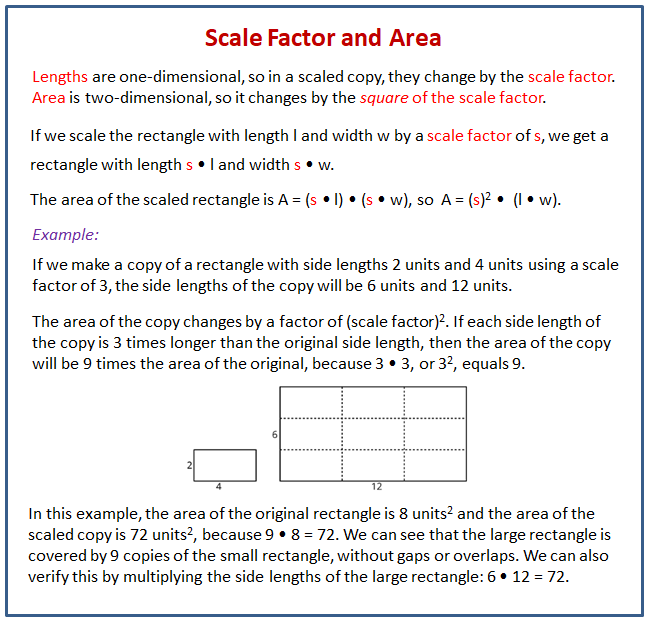Illustrative Mathematics Grade 7, Unit 1, Lesson 6: Scaling and Area
Learning Targets:
- I can describe how the area of a scaled copy is related to the area of the original figure and the scale factor that was used.
Related Pages
Illustrative Math
Grade 7
Lesson 6: Scaling and Area
Let’s build scaled shapes and investigate their areas.
Illustrative Math Unit 7.1, Lesson 6 (printable worksheets)
Lesson 6 Summary
The following diagram shows how the area of a scaled copy is related to the area of the original figure and the scale factor that was used.

Lesson 6.1 Number Talk: Missing Factor
Scaling a Pattern Block
-
How many blue rhombus blocks does it take to build a scaled copy of Figure A:
a. Where each side is twice as long?
b. Where each side is 3 times as long?
c. Where each side is 4 times as long?
Open Applet -
How many green triangle blocks does it take to build a scaled copy of Figure B:
a. Where each side is twice as long?
b. Where each side is 3 times as long?
c. Using a scale factor of 4?
Open Applet -
How many red trapezoid blocks does it take to build a scaled copy of Figure C:
a. Using a scale factor of 2?
b. Using a scale factor of 3?
c. Using a scale factor of 4?
Open Applet -
Make a prediction: How many blocks would it take to build scaled copies of these shapes using a scale factor of 5? Using a scale factor of 6? Be prepared to explain your reasoning.
Lesson 6.2 Scaling More Pattern Blocks
Your teacher will assign your group one of these figures, each made with original-size blocks.
- In the applet, move the slider to see a scaled copy of your assigned shape, using a scale factor of 2. Use the original-size blocks to build a figure to match it. How many blocks did it take?
- Explain why doubling the blocks was not enough to match the scaled copy, even though the scale factor was 2.
- Move the slider to see a scaled copy of your assigned shape using a scale factor of 3. Start building a figure with the original-size blocks to match it. Stop when you can tell for sure how many blocks it would take. Record your answer.
- Predict: How many blocks would it take to build scaled copies using scale factors 4, 5, and 6? Explain or show your reasoning.
- How is the pattern in this activity the same as the pattern you saw in the previous activity? How is it different?
- Discuss your answers with another group that worked on the same shape until you reach an agreement. Be prepared to share your reasoning with the class.
Open Applet
Open Applet
Open Applet
Are you ready for more?
- How many blocks do you think it would take to build a scaled copy of one yellow hexagon where each side is twice as long? Three times as long?
- Figure out a way to build these scaled copies.
- Do you see a pattern for the number of blocks used to build these scaled copies? Explain your reasoning.
Lesson 6.3 Area of Scaled Parallelograms and Triangles
- Your teacher will give you a figure with measurements in centimeters. What is the area of your figure? How do you know?
- Work with your partner to draw scaled copies of your figure, using each scale factor in the table. Complete the table with the measurements of your scaled copies.
- Compare your results with a group that worked with a different figure. What is the same about your answers? What is different?
- If you drew scaled copies of your figure with the following scale factors, what would their areas be? Discuss your thinking. If you disagree, work to reach an agreement. Be prepared to explain your reasoning.
Lesson 6 Practice Problems
- On the grid, draw a scaled copy of Polygon Q using a scale factor of 2. Compare the perimeter and area of the new polygon to those of Q.
- A right triangle has an area of 36 square units.
If you draw scaled copies of this triangle using the scale factors in the table, what will the areas of these scaled copies be? Explain or show your reasoning. - Diego drew a scaled version of a Polygon P and labeled it Q.
If the area of Polygon P is 72 square units, what scale factor did Diego use to go from P to Q? Explain your reasoning. - Here is an unlabeled polygon, along with its scaled copies Polygons A–D. For each copy, determine the scale factor. Explain how you know.
- Solve each equation mentally.
a. 1/7 · x = 1
b. x · 1/11 = 1
c. 1 ÷ 1/5 = x
The Open Up Resources math curriculum is free to download from the Open Up Resources website and is also available from Illustrative Mathematics.
Try out our new and fun Fraction Concoction Game.
Add and subtract fractions to make exciting fraction concoctions following a recipe. There are four levels of difficulty: Easy, medium, hard and insane. Practice the basics of fraction addition and subtraction or challenge yourself with the insane level.

We welcome your feedback, comments and questions about this site or page. Please submit your feedback or enquiries via our Feedback page.